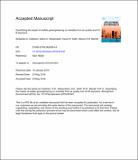Quantifying the impact of sulfate geoengineering on mortality from air quality and UV-B exposure
Author(s)
Eastham, Sebastian David; Weisenstein, Debra K.; Keith, David W.; Barrett, Steven R. H.
DownloadAccepted version (1.701Mb)
Publisher with Creative Commons License
Publisher with Creative Commons License
Creative Commons Attribution
Terms of use
Metadata
Show full item recordAbstract
Sulfate geoengineering is a proposed method to partially counteract the global radiative forcing from accumulated greenhouse gases, potentially mitigating some impacts of climate change. While likely to be effective in slowing increases in average temperatures and extreme precipitation, there are known side-effects and potential unintended consequences which have not been quantified. One such consequence is the direct human health impact. Given the significant uncertainties, we take a sensitivity approach to explore the mechanisms and range of potential impacts. Using a chemistry-transport model, we quantify the steady-state response of three public health risks to 1 °C global mean surface cooling. We separate impacts into those which are “radiative forcing-driven”, associated with climate change “reversal” through modification of global radiative forcing, and those “direct impacts” associated uniquely with using sulfate geoengineering to achieve this. We find that the direct (non-radiative forcing driven) impact is a decrease in global mortality of ∼13,000 annually. Here the benefits of reduced ozone exposure exceed increases in mortality due to UV and particulate matter, as each unit of injected sulfur incurs 1/25th the particulate matter exposure of a unit of sulfur emitted from surface sources. This reduction is exceeded by radiative forcing-driven health impacts resulting from using sulfate geoengineering to offset 1 °C of surface temperature rise. Increased particulate matter formation at these lower temperatures results in ∼39,000 mortalities which would have been avoided at higher temperatures. As such we estimate that sulfate geoengineering in 2040 would cause ∼26,000 (95% interval: −30,000 to +79,000) early deaths annually relative to the same year without geoengineering, largely due to the loss of health benefits associated with CO2-induced warming. These results account only for impacts due to changes in air quality and UV-B flux. They do not account for non-mortality impacts or changes in atmospheric dynamics, and must be considered in the wider context of other climate change impacts such as heatwave frequency and sea level rise.
Date issued
2018-08Department
Massachusetts Institute of Technology. Laboratory for Aviation and the Environment; Massachusetts Institute of Technology. Department of Aeronautics and AstronauticsJournal
Atmospheric Environment
Publisher
Elsevier BV
Citation
Eastham, Sebastian D. et al. "Quantifying the impact of sulfate geoengineering on mortality from air quality and UV-B exposure." Atmospheric Environment 187 (August 2018): 424-434 © 2018 Elsevier Ltd
Version: Author's final manuscript
ISSN
1352-2310